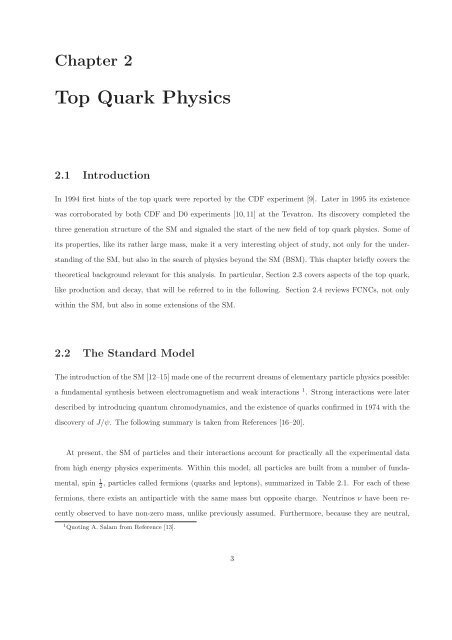CERN-THESIS-2012-153 26/07/2012 - CERN Document Server
CERN-THESIS-2012-153 26/07/2012 - CERN Document Server
CERN-THESIS-2012-153 26/07/2012 - CERN Document Server
You also want an ePaper? Increase the reach of your titles
YUMPU automatically turns print PDFs into web optimized ePapers that Google loves.
Chapter 2<br />
Top Quark Physics<br />
2.1 Introduction<br />
In 1994 first hints of the top quark were reported by the CDF experiment [9]. Later in 1995 its existence<br />
was corroborated by both CDF and D0 experiments [10,11] at the Tevatron. Its discovery completed the<br />
three generation structure of the SM and signaled the start of the new field of top quark physics. Some of<br />
its properties, like its rather large mass, make it a very interesting object of study, not only for the under-<br />
standing of the SM, but also in the search of physics beyond the SM (BSM). This chapter briefly covers the<br />
theoretical background relevant for this analysis. In particular, Section 2.3 covers aspects of the top quark,<br />
like production and decay, that will be referred to in the following. Section 2.4 reviews FCNCs, not only<br />
within the SM, but also in some extensions of the SM.<br />
2.2 The Standard Model<br />
The introduction of the SM [12–15] made one of the recurrent dreams of elementary particle physics possible:<br />
a fundamental synthesis between electromagnetism and weak interactions 1 . Strong interactions were later<br />
described by introducing quantum chromodynamics, and the existence of quarks confirmed in 1974 with the<br />
discovery of J/ψ. The following summary is taken from References [16–20].<br />
At present, the SM of particles and their interactions account for practically all the experimental data<br />
from high energy physics experiments. Within this model, all particles are built from a number of funda-<br />
mental, spin 1<br />
2 , particles called fermions (quarks and leptons), summarized in Table 2.1. For each of these<br />
fermions, there exists an antiparticle with the same mass but opposite charge. Neutrinos ν have been re-<br />
cently observed to have non-zero mass, unlike previously assumed. Furthermore, because they are neutral,<br />
1 Quoting A. Salam from Reference [13].<br />
3















